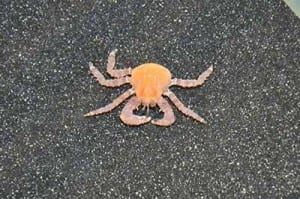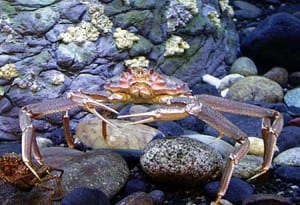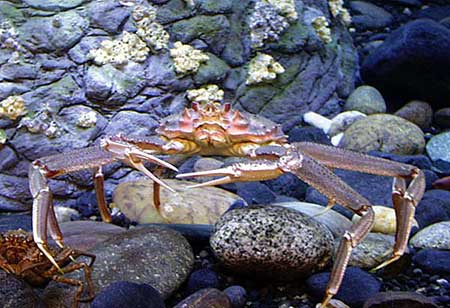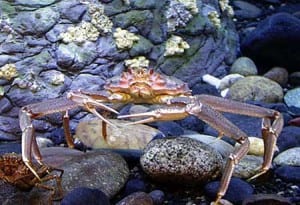Several new studies out are adding to the growing body of research that acidic ocean waters could harm some of the crab caught in Alaskan waters.
There’s hope that some types of crab may be able to adapt to ocean acidification, but otherwise crab populations and commercial catches are projected to decline.
Scientists with NOAA Fisheries’ Alaska Fisheries Science Center in Kodiak tested the youngest life stages of Tanner and blue king crab against different levels of acidic water.


Chris Long, fisheries ecologist with NOAA Fisheries says scientists tested a two-year exposure to more acidic water, because it takes that long to get through the reproductive cycle for Tanners. Long says the good news is Tanner crab at the larval stage were fairly robust and able to survive lower pH levels, or more acidic water. But that was not the case at the embryo stage.
“The first year the embryos all hatched and they all looked good,” Long said. “So these were larvae that were hatching from just embryos that had been in acidified water. But in the second year we had, it wasn’t quite complete, but I think it was about 70 percent mortality of the embryos either right before they hatched or right after they hatched. They were kindof all stillborn was the way it came out.”
Long and other scientists published their results in the February/March edition of the ICES Journal of Marine Science. This latest research builds on findings announced in 2013 on red king and Tanner development.
The world’s oceans are becoming more acidic as they absorb carbon dioxide, a trend that’s projected to continue. Long thinks the young crab are likely stressed by the change in water chemistry. “Whatever animals are living in the water, if what your living in is surrounded, the acidity goes up, then that affects your physiology inside of you,” he explained. “And you know, just for a comparison if your blood changes by about .04 pH units, you go into acidosis and can go into shock. That’s about double what the change has already been in the oceans and it’s only going to accelerate with future increases in CO2.”
The research showed some young Tanner crab were able to survive low pH levels. That could mean the species may be able to adapt to the acidic water over generations.
Another scientist with the University of Washington, Andre Punt, used the studies to evaluate potential impacts on crab fisheries. Punt projects fishing fleets will be seeing lower catches in 40-50 years if the species are not able to adapt to the changing ocean conditions.
A separate study looked at juvenile blue king crab and the results were presented at the Alaska Marine Science Symposium in Anchorage at the end of January. The work showed a more positive outcome for that species. In waters with a lower pH level, more acidity, juvenile blue king crab died during the first 100 days of the study. However, Long said none of the small crab died in the last 200 days. “What that’s suggesting to me is that the blue king crab actually have a fairly adaptive physiology,” he said. “And so if you give them a little time they can change their physiology so they’re now able to live in the low pH conditions.”
Crabs in the more acidic water also grew at a slower rate, which could show an adaptation to different conditions. The research showed that blue king crab were a lot less sensitive to acidic water than red kings, a closely related species, with similar ranges and habitat types. Future studies will look at snow crab along with impacts on how the different species are able to grow shells in more acidic water.
There’s a link to the articles here.













